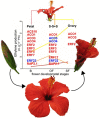Ethylene Role in Plant Growth, Development and Senescence: Interaction with Other Phytohormones
- PMID: 28421102
- PMCID: PMC5378820
- DOI: 10.3389/fpls.2017.00475
Ethylene Role in Plant Growth, Development and Senescence: Interaction with Other Phytohormones
Abstract
The complex juvenile/maturity transition during a plant's life cycle includes growth, reproduction, and senescence of its fundamental organs: leaves, flowers, and fruits. Growth and senescence of leaves, flowers, and fruits involve several genetic networks where the phytohormone ethylene plays a key role, together with other hormones, integrating different signals and allowing the onset of conditions favorable for stage progression, reproductive success and organ longevity. Changes in ethylene level, its perception, and the hormonal crosstalk directly or indirectly regulate the lifespan of plants. The present review focused on ethylene's role in the development and senescence processes in leaves, flowers and fruits, paying special attention to the complex networks of ethylene crosstalk with other hormones. Moreover, aspects with limited information have been highlighted for future research, extending our understanding on the importance of ethylene during growth and senescence and boosting future research with the aim to improve the qualitative and quantitative traits of crops.
Keywords: VOCs; ethylene; flower senescence; fruit ripening; leaf senescence; phytohormones.
Figures


Similar articles
-
To grow old: regulatory role of ethylene and jasmonic acid in senescence.Front Plant Sci. 2015 Jan 29;6:20. doi: 10.3389/fpls.2015.00020. eCollection 2015. Front Plant Sci. 2015. PMID: 25688252 Free PMC article.
-
Ethylene and its crosstalk with hormonal pathways in fruit ripening: mechanisms, modulation, and commercial exploitation.Front Plant Sci. 2024 Nov 7;15:1475496. doi: 10.3389/fpls.2024.1475496. eCollection 2024. Front Plant Sci. 2024. PMID: 39574438 Free PMC article. Review.
-
Mineral nutrient remobilization during corolla senescence in ethylene-sensitive and -insensitive flowers.AoB Plants. 2013;5:plt023. doi: 10.1093/aobpla/plt023. Epub 2013 May 9. AoB Plants. 2013. PMID: 23671789 Free PMC article.
-
Mutations in tomato 1-aminocyclopropane carboxylic acid synthase2 uncover its role in development beside fruit ripening.Plant J. 2021 Apr;106(1):95-112. doi: 10.1111/tpj.15148. Epub 2021 Feb 1. Plant J. 2021. PMID: 33370496
-
Molecular understanding of postharvest flower opening and senescence.Mol Hortic. 2021 Aug 24;1(1):7. doi: 10.1186/s43897-021-00015-8. Mol Hortic. 2021. PMID: 37789453 Free PMC article. Review.
Cited by
-
Monitoring of Post-Harvest Maturation Processes inside Stored Fruit Using Photoacoustic Gas Sensing Spectroscopy.Materials (Basel). 2020 Jun 12;13(12):2694. doi: 10.3390/ma13122694. Materials (Basel). 2020. PMID: 32545671 Free PMC article.
-
24-Epibrasinolide Modulates the Vase Life of Lisianthus Cut Flowers by Modulating ACC Oxidase Enzyme Activity and Physiological Responses.Plants (Basel). 2021 May 17;10(5):995. doi: 10.3390/plants10050995. Plants (Basel). 2021. PMID: 34067603 Free PMC article.
-
Auxin regulated metabolic changes underlying sepal retention and development after pollination in spinach.BMC Plant Biol. 2021 Apr 6;21(1):166. doi: 10.1186/s12870-021-02944-4. BMC Plant Biol. 2021. PMID: 33823793 Free PMC article.
-
Protein Hydrolysates from Animal or Vegetal Sources Affect Morpho-Physiological Traits, Ornamental Quality, Mineral Composition, and Shelf-Life of Chrysanthemum in a Distinctive Manner.Plants (Basel). 2022 Sep 5;11(17):2321. doi: 10.3390/plants11172321. Plants (Basel). 2022. PMID: 36079702 Free PMC article.
-
De novo transcriptome assembly of transgenic tobacco (Nicotiana tabacum NC89) with early senescence characteristic.Physiol Mol Biol Plants. 2021 Feb;27(2):237-249. doi: 10.1007/s12298-021-00953-z. Epub 2021 Feb 19. Physiol Mol Biol Plants. 2021. PMID: 33707866 Free PMC article.
References
-
- Abeles F. B., Morgan P. W., Saltveit M. E., Jr. (1992). Ethylene in Plant Biology, 2nd Edn San Diego, CA: Academic Press.
-
- Achard P., Baghour M., Chapple A., Hedden P., Van Der Straeten D., Genschik P., et al. (2007). The plant stress hormone ethylene controls floral transition via DELLA-dependent regulation of floral meristem-identity genes. Proc. Natl. Acad. Sci. U.S.A. 104 6484–6489. 10.1073/pnas.0610717104 - DOI - PMC - PubMed
Publication types
LinkOut - more resources
Full Text Sources
Other Literature Sources

